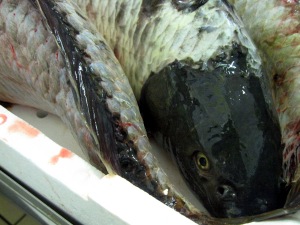A bone-chilling wind whistled across the water, as I huddled on a boat with fingers tucked into my armpits. We were sailing across Lake Trasimeno, the second largest body of freshwater in Italy. Aurelio, our captain and president of the local Trasimeno fishermen’s cooperative, explained that the maximum depth of the lake was about 5 m, and the area we were currently in was only 1,8-2 m deep. Moreover, this is an endorheic body of water, a lake with no natural outlets that is entirely rain-fed. Essentially, we were rocking our way across a giant puddle.
It may not look like much, but Lake Trasimeno is actually the cleanest lake in Italy, according to tests conducted by environmental agencies. There are no industrial zones located nearby with potentially polluting run-off, and the surrounding areas are sparsely populated. The lake boasts a healthy population of plankton, which results in clean and fresh-tasting fish.
Since the volume depends solely on rainfall, the lake’s water level fluctuates widely. In the 1950s, there was a streak of dry seasons and the lake level fell so drastically that many real estate capitalists were speculating on whether the lake could be drained entirely to construct new houses. Luckily, the ’60s brought more rain and the idea was scrapped. Currently, the lake is 60-80 cm below normal level.
As we watched the fishermen work, a flock of fulica birds (coots) floating on the lake noticed our puttering motorboat’s presence. With a susurrant crescendo, they beat their wings furiously and rose as a black cloud into the sky.
The Trasimeno fishermen use non-intensive fishing methods for their catch, employing nets and funnel-shaped throats to trap fish. Fish go into the nets, which are checked every 1-2 days, and stay live until they are pulled by the fishermen. Smaller fish will be thrown back into the water. The quantity of fish caught is dependent on the time of day, weather, wind, temperature and season.
Pike, carp, trout and tench are some of the most common fish found in Lake Trasimeno, along with a large “killer” crayfish that was introduced to the lake by unknown sources. “They can be a bit muddy,” said Aurelio, “but they’re good with pasta.” You can also find eels in the lake, but the population of eels has been depleted in recent years. For a while, baby eels were put into the lake to boost and replenish the eel population, but these days it is not cost-effective to do this because farmed eels and Japanese exports are cheaper.
Global competition means that the fishermen are often struggling to support themselves, and joining the Trasimeno fishing coop is one way to bring financial stability and boost the visibility of Lake Trasimeno’s seafood. There are 35 members of the coop from three villages: San Feliciano, Torricella and Sant’Arcangelo. Of these, 30 are retired. However, last September, four new fishermen joined the coop, giving new hope to the tradition of small-scale fishing on Trasimeno. “This is a difficult career,” said Aurelio. “Only crazy people start doing this job nowadays. But for me, fishing is like a drug, you can’t stop doing it.”
To further attract the young, the coop is seeking ways to diversify and broaden the scope of a fisherman’s duties. They have promoted pescaturismo, or fishing tourism akin to the popular agriturismo industry on Italian farms. There are also plans in the works to operate a food truck at food fairs and festivals, to better showcase fish from Trasimeno, as well as plans to open a restaurant to serve the daily catch and educate consumers about eating local seafood.
Off amongst a bed of reeds, the temperature was considerably warmer with the wind break. A bright red gate in the distance marked the entrance to an ancient canal dating back from Roman times. The canal flows to another river, which flows to the Tiber and eventually empties into the sea. The gate was set up to prevent flooding, but the lake level is so low now that Aurelio doubts it will ever be used again.
Clockwise: freshly caught eels; preparing fish fillets; small latterino fish are excellent for frying; larger fish in a tub
Back on shore, we investigated the weigh station and fish processing operations. In a small, pleasantly briny building, workers deftly filleted and deboned the catch of the day. The fish must be filleted by hand, rather than machine, because they are not uniform sizes. Thus, the final price for fillets is a relatively high €14/kg, with three kilos of raw fish going into every kilo of fillets. Farmed tilapia from Thailand is much cheaper in comparison. Smaller fish, like the silver latterino will be reserved for whole frying, or perhaps smoking.
There’s nothing quite like seeing eye-to-eye with your lunch.










